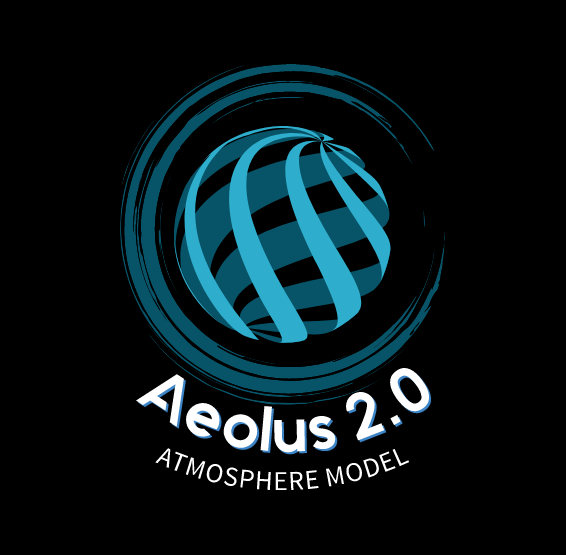
Model Description
Aeolus 2.0 is an in-house open-source numerical model designed to simulate atmospheric circulations. The model's dynamical core is based on a multi-layer pseudo-spectral moist-convective Thermal Rotating Shallow Water (mcTRSW) model. The Dedalus algorithm, renowned for its handling of spin-weighted spherical harmonics, manages the pseudo-spectral problem-solving tasks. One advantage of spin-weighted spherical harmonics is that differentiation on the sphere remains regular everywhere. In the classical setup of shallow-water models, the fluid is homogeneous, incompressible, and under hydrostatic balance. Therefore, gradients of mean temperature and density are invariant in this setup. However, the TRSW model employs inhomogeneous layers, allowing horizontal variations in potential temperature. The elucidation of the multi-layer Thermal Rotating Shallow Water (TRSW) model and its associated moist convection, characterized by minimal parameterization across the entire spherical domain, has been comprehensively detailed in the publication by Rostami et al., 2022.
The model captures the temporal and spatial evolution of vertically integrated potential temperature, pressure, water vapor, precipitation, and the intricate influence of bottom topography. It comprehensively characterizes velocity fields in both the lower and upper troposphere, employing resolutions spanning a spectrum from smooth to coarse. This enables the exploration of a wide range of dynamic phenomena with varying levels of complexity.
Layer versus Level Models
Another feature of Aeolus 2.0 is that it is a layer model. Layer models and level models are two approaches used in geophysical fluid dynamics to represent the vertical structure of the atmosphere and oceans. While level models incorporate thermodynamics easily, they are less accurate than layer models, especially at high vertical modes. The difference lies in how these models represent the density profile. In a level model, density is assumed to be continuously stratified, and finite differencing is used at fixed depths. In contrast, a layer model approximates the continuous density profile with a piece-wise constant profile, where the depth of the interfaces can vary with position and time. Accuracy issues in level models arise from the inherent limitations of finite differencing at small scales. In contrast, layer models do not suffer from this problem because the piece-wise constant density profile is physically valid, and the equations of motion precisely represent this particular stratification. The Laplace tidal equations serve as a prominent example that highlights the disparity between layer and level models. These equations, which describe the behavior of tides in the ocean and atmosphere, are a one-layer model with no counterpart in the level model family.
Spin-Weighted Spherical Harmonics
In the numerical methodology employed in Aeolus 2.0, the Dedalus algorithm is utilized. The Dedalus algorithm incorporates the use of spin-weighted spherical harmonics, as documented in the works of Vasil et al. (2019) and Lecoanet et al. (2019). Spin-weighted spherical harmonics were originally introduced by Gelfand and Shapiro (1956) in their studies related to the Lorenz group. One key advantage of utilizing spin-weighted spherical harmonics in combination with spinor basis vectors is the ability to perform differentiation operations on the spherical domain in a manner akin to Fourier series operations. This property enables regular and well-behaved diagonal wavenumber multiplication across the entire sphere, eliminating the necessity for traditional singular gradients at the poles. This advantageous feature enhances the numerical stability and accuracy of calculations performed within the mcTRSW dynamical core on a spherical domain.
How Does Aeolus 2.0 Differ from Others in the Community?
The widely employed Rotating Shallow Water (RSW) model has proven valuable for investigating atmospheric and oceanic flows. It integrates the atmospheric primitive equations using pseudo-height isobaric vertical coordinates, enabling the capture of critical features of large-scale fluid dynamics, including jet streams and Rossby waves. However, the classical RSW model has limitations, notably in its neglect of horizontal gradients of potential temperature and the influence of moist convection, both of which are significant in specific atmospheric and oceanic contexts. These effects, driven by the interaction between temperature and water vapor content, lead to the formation of clouds, precipitation, and other atmospheric features. To overcome these limitations, the mcTRSW dynamical core incorporates horizontal gradients of potential temperature and moist convection, enhancing the accuracy of atmospheric current simulations beyond that of classical RSW models. This, in turn, makes the mcTRSW dynamical core an ideal choice for the investigation of fully nonlinear evolution of large-scale temperature anomalies in a moist-convective or adiabatic environments. Aeolus 2.0 is indeed a proper choice for studying extreme events such as the Madden-Julian Oscillation (MJO), tropical cyclones, extreme heatwaves, monsoons, and more (Rostami et al., 2023). It offers valuable insights into the intricate interplay between temperature, water vapor content, and large-scale atmospheric dynamics. The model is supported by a theoretical foundation and a historical record of incorporating moist convection in the RSW model (mcRSW), which already accounts for phase transitions of water vapor and the related latent heat release (Bouchut et al., 2009; Rostami & Zeitlin, 2018).
In order to answer scientific questions and trace causalities, the user can configure the various levels of complexity in the model, ranging from a conceptual level to an intermediate level of complexity.
Aeolus 2. 0 Installation and Execution Guide
Aeolus 2.0 has been uploaded to Zenodo and is available via the following link: DOI: 10.5281/zenodo.10054154 (Rostami et al., 2024). The README file guides users through the installation and execution of Aeolus 2.0. The model utilizes parallel computing, enabling the distribution of computational tasks for faster and more efficient simulations.
Aeolus 2.0 Subscription
For access to the latest version of the model, contact Masoud Rostami via email or subscribe for latest version of Aeolus 2.0 and updates: Click here to subscribe:
Copyright and Terms of Use
The software is licensed under the Creative Commons Attribution 4.0 International License, allowing users to freely use and adapt the code for research purposes. The author provides no warranties, express or implied, including merchantability, fitness for a particular purpose, non-infringement, or absence of errors. The author disclaims any liability for direct or indirect loss, damage, or issues arising from the use or inability to use the software.
Maintainers and Developers
The stand-alone version of the model was originally initiated by Masoud Rostami. Subsequently, both the stand-alone version and its coupled counterpart with intermediate complexity were maintained, developed, and spearheaded by Masoud Rostami, Stefan Petri, and Stefan Rahmstorf within Research Department 1 (RD1).
Future Prospects of Aeolus 2.0
A visionary step in Aeolus 2.0's evolution involves its integration with the Potsdam Earth System Model (POEM) as one of its atmospheric components. This integration signifies a progression toward an Earth system modeling framework that captures interactions and feedback mechanisms among the atmosphere, oceans, land surface, and biosphere. This step enables fast simulations of climate evolution on millennial scales.
Reporting a Problem
As the configuration of the model for addressing diverse scientific inquiries may vary based on the specific topic of interest, should you encounter any challenges during the processes of installation, nondimensionalization, external forcing, and other related aspects, kindly direct your inquiries to Masoud Rostami via email. Your correspondence will enable us to provide targeted assistance and ensure the effective implementation of the model for your scientific inquiries.
Additionally, we welcome collaboration opportunities and invite researchers to explore joint projects or share insights for mutual scientific advancement. We look forward to fostering collaborative endeavors that contribute to the broader scientific community's understanding of atmospheric processes.
References
Lecoanet, D., Vasil, G. M., Burns, K. J., Brown, B. P., & Oishi, J. S. (2019). Tensor calculus in spherical coordinates using Jacobi polynomials. Part–II: Implementation and examples. Journal of Computational Physics: X, 3 , 100012. Available from https://doi.org/10.1016/j.jcpx.2019.100012
Vasil, G. M., Lecoanet, D., Burns, K. J., Oishi, J. S., & Brown, B. P. (2019). Tensor calculus in spherical coordinates using Jacobi polynomials. Part–I: Mathematical analysis and derivations. Journal of Computational Physics: X, 3 , 100013. Available from https://doi.org/10.1016/j.jcpx.2019.100013







